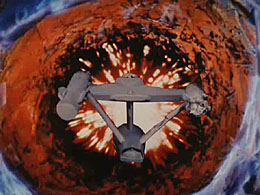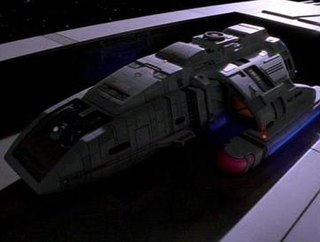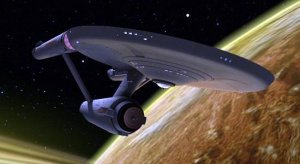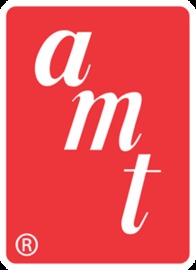Star Trek is an American science fiction television series created by Gene Roddenberry that follows the adventures of the starship USS Enterprise (NCC-1701) and its crew. It acquired the retronym of Star Trek: The Original Series to distinguish the show within the media franchise that it began.
Enterprise or USS Enterprise, often referred to as the Starship Enterprise, is the name of several fictional spacecraft, some of which are the main craft and setting for various television series and films in the Star Trek science fiction franchise. The most notable were Captain James T. Kirk's USS Enterprise (NCC-1701) from the original 1960s television series, and Captain Jean-Luc Picard's USS Enterprise (NCC-1701-D) from Star Trek: The Next Generation.

Spock is a fictional character in the Star Trek media franchise. He first appeared in the original Star Trek series serving aboard the starship USS Enterprise as science officer and first officer and later as commanding officer of the vessel. Spock's mixed human–Vulcan heritage serves as an important plot element in many of the character's appearances. Along with Captain James T. Kirk and Dr. Leonard "Bones" McCoy, he is one of the three central characters in the original Star Trek series and its films. After retiring from active duty in Starfleet, Spock served as a Federation ambassador, and later became involved in the ill-fated attempt to save Romulus from a supernova, leading him to live out the rest of his life in a parallel universe.
"The City on the Edge of Forever" is the twenty-eighth and penultimate episode of the first season of the American science fiction television series Star Trek. It was written by Harlan Ellison; contributors to and/or editors of the script included Steven W. Carabatsos, D. C. Fontana and Gene L. Coon. Gene Roddenberry made the final re-write. The episode was directed by Joseph Pevney and first aired on NBC on April 6, 1967.
"Space Seed" is the 22nd episode of the first season of the American science fiction television series Star Trek. It was first broadcast by NBC on February 16, 1967. "Space Seed" was written by Gene L. Coon and Carey Wilber and directed by Marc Daniels.

"The Doomsday Machine" is the sixth episode of the second season of the American science fiction television series Star Trek. Written by Norman Spinrad and directed by Marc Daniels, it was first broadcast on October 20, 1967.

Runabouts are a fictional class of small, multi-purpose starships appearing in the Star Trek science-fiction franchise, primarily the television series Star Trek: Deep Space Nine, which aired on syndicated television between 1993 and 1999. They served as a means of transport for the crew of the fictional space station Deep Space Nine, in the early seasons of the series enabling storylines taking place away from the station.

USS Enterprise (NCC-1701) is a starship in the Star Trek media franchise. It is the main setting of the original Star Trek television series (1966–69), and it is depicted in films, other television series, spin-off fiction, products, and fan-created media. Under the command of Captain James T. Kirk, the Enterprise carries its crew on a mission "to explore strange, new worlds; to seek out new life and new civilizations; to boldly go where no man has gone before." Star Trek: Strange New Worlds (2022–present) depicts the Enterprise under the command of Kirk's predecessor, Captain Christopher Pike.

USS Enterprise (NCC-1701-D), or Enterprise-D, to distinguish it from other vessels with the same name, is a starship in the Star Trek media franchise. Under the command of Captain Jean-Luc Picard, it is the main setting of Star Trek: The Next Generation (1987–1994) and the film Star Trek Generations (1994). It has also been depicted in various spinoffs, films, books, and licensed products.

Janice Rand is a fictional character in the American science fiction television series Star Trek: The Original Series during its first season, as well as three of the Star Trek films. She is the Captain's yeoman on board the USS Enterprise (NCC-1701), and first appeared in the episode "The Man Trap". She had significant roles in the episodes "The Enemy Within", where she fights off an evil version of Captain James T. Kirk; "Charlie X" where a young man with god-like powers falls in love with her; and "Miri" where she is infected with a deadly disease while on an away mission and is kidnapped by jealous children.

The Menagerie is a two-part episode from the first season of the American science fiction television series Star Trek. It comprises the eleventh and twelfth broadcast episodes of the series. Written by series creator Gene Roddenberry, with portions directed by Marc Daniels and portions directed by Robert Butler, it is the only two-part story in the original series. Part I was broadcast by NBC on November 17, 1966, and Part II was broadcast on November 24, 1966. In the episode, Spock abducts his former commanding officer, Fleet Captain Christopher Pike, locks the starship Enterprise on a course to the forbidden planet Talos IV and turns himself in for court-martial where he presents an elaborate story explaining his actions.
"The Man Trap" is the first episode of season one of the American science fiction television series Star Trek. Written by George Clayton Johnson and directed by Marc Daniels, it featured design work by Wah Chang and first aired in the United States on September 8, 1966.
"The Galileo Seven" is the sixteenth episode of the first season of the American science fiction television series Star Trek. Written by Oliver Crawford and directed by Robert Gist, it first aired on January 5, 1967.
"The Return of the Archons" is the twenty-first episode of the first season of the American science fiction television series Star Trek. Written by Boris Sobelman, and directed by Joseph Pevney, it first aired on February 9, 1967.
"Metamorphosis" is the ninth episode of the second season of the American science fiction television series Star Trek. Written by Gene L. Coon and directed by Ralph Senensky, it was first broadcast on November 10, 1967.
"The Empath" is the twelfth episode of the third season of the American science fiction television series Star Trek. Written by Joyce Muskat and directed by John Erman, it was first broadcast on December 6, 1968.
Shuttlecraft are fictional vehicles in the Star Trek science fiction franchise built for short trips in space, such as between a planetary surface and orbit. Also referred to as shuttles, their introduction preceded the development of the Space Shuttle.
"The Way to Eden" is the twentieth episode of the third season of the American science fiction television series Star Trek. The episode was written by Arthur Heinemann, based on a story by Heinemann and D. C. Fontana. It was directed by David Alexander, and first broadcast on February 21, 1969.

Aluminum Model Toys (AMT) is an American brand of scale model vehicles. The former manufacturing company was founded in Troy, Michigan, in 1948 by West Gallogly Sr. AMT became known for producing 1:25 scale plastic automobile dealer promotional model cars and friction motor models, and pioneered the annual 3-in-1 model kit buildable in stock, custom, or hot-rod versions. The company made a two-way deal in 1966 with Desilu Productions to produce a line of Star Trek models and to produce a 3/4 scale exterior and interior filming set of the Galileo shuttlecraft. It was also known for producing model trucks and movie and TV vehicles.
The Star Trek franchise features many spacecraft. Various space vessels make up the primary settings of the Star Trek television series, films, and expanded universe; others help advance the franchise's stories. Throughout the franchise's production, spacecraft have been depicted by numerous physical and computer-generated models. Producers worked to balance often tight budgets with the need to depict convincing, futuristic vessels.









